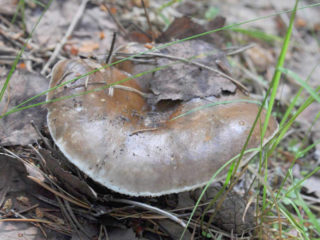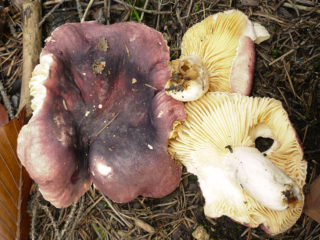Content
Russula is a very healthy and tasty mushroom, which in many areas is considered a real delicacy. In order not to pass by this fungus in the forest and to properly process it after collection, you need to read the detailed description.
Where do russulas grow brown?
You can find brown russula throughout the middle zone, as well as in the more northern regions of Russia. Most often, mushrooms grow in coniferous forests, mainly pine, but they can choose oak and birch forests as their habitat.
Fungi grow both singly and in small families, but single mushrooms are more common. You can see the fungus in the forest as early as July, and fruiting continues until October.
What do russulas turn brown look like?
Like other mushrooms from the Russula family, young brown fungi have a convex cap, while adults have a flat cap with slightly curved edges. The diameter of the cap grows to approximately 8 cm, the color of the skin in the upper part varies from dark olive to burgundy at a young age, and more often becomes brown-yellow in adulthood. The mushroom cap looks and feels dry, smooth and matte. The lower surface consists of frequent white plates; in old mushrooms it is yellow-brown.
Photos and descriptions of browning russula indicate that the fungus usually rises above the ground by no more than 7 cm, the rounded leg reaches 2 cm in girth. Young mushrooms have a dense stem with pulp inside, but over time it becomes hollow. The color of the leg is white or with reddish tints. When cut, the flesh of the fungus is elastic and dense, slightly yellowish and darkening in air.
Is it possible to eat russula turning brown?
The mushroom belongs to the edible category - it is definitely allowed to eat it. Moreover, brown russula is considered a delicious delicacy; it is highly valued not only in Russia, but also in European countries.
Taste qualities of russula browning
Browning fungus has two great advantages at once. First of all, it tastes very pleasant, not only when salted, but also after boiling or frying.A fresh mushroom can be frightening with the strong smell of herring, but if you boil the pulp for a short time, the specific aroma will completely disappear.
In addition, browning russula requires minimal heat treatment. It is not even necessary to soak it, like most other mushrooms; cleaned and washed mushrooms just need to be rinsed in cold water before cooking or frying. This also increases the culinary popularity of the fungus.
Benefits and harms
The tasty pulp can have a very beneficial effect on the human body. The fungus contains vitamins and microelements, fiber and organic acids, amino acids and enzymes.
Thanks to this, the fungus provides the following health benefits:
- improves metabolic processes and helps cleanse the body;
- increases endurance and strengthens the immune system;
- has a healing effect on blood vessels and the heart;
- prevents the development of atherosclerosis and reduces cholesterol levels;
- helps you lose weight without harm to your health - 100 g of mushrooms contain only 19 kcal.
At the same time, beneficial browning russula can also have a negative effect on the body. You need to stop using them:
- in the presence of individual allergies;
- if you are under 7 years of age, it is better for young children not to try mushrooms at all;
- for acute stomach ailments;
- with pancreatitis;
- for severe intestinal diseases.
It is necessary to remember the norms of consumption; you can eat browning fungi in an amount of no more than 150 g per day. It is also not recommended to eat fungi in the evening; they take a long time to digest, and if you eat them too late, it will prevent you from falling asleep and cause discomfort in the stomach.
Collection rules
It is necessary to collect brown russula in ecologically clean areas closer to autumn. Most mushrooms are found in August and September, when they grow especially abundantly.
For food purposes, it is best to cut young mushrooms. It is quite easy to recognize them - the cap of young brown russula usually still retains a slight convexity, and the plates on the underside remain completely white and intact. It is better to avoid old mushrooms; most often they are heavily damaged by insects, and they simply cannot be used for food. In addition, the taste of overgrown browning russula is much worse; their flesh is hard and dense, and they do not have a delicious taste.
False doubles of Russula turning brown
The fungus has a fairly recognizable appearance, but it can still be confused with some other mushrooms. False twins of brown russula are mainly fungi from the same family.
Almond Russula
The structure and size of the mushrooms are very similar to each other. However, the cap of the almond variety is ocher or honey-tinged. The main difference is the taste and smell, as the name suggests, almond russula smells distinctly of almonds, but it tastes quite pungent.
Golden-red russula
Another mushroom similar to the brown russula differs from it in its red-orange brick cap with a slight purple tint.The taste of the fungus is quite pleasant, sweetish, but it can be distinguished by its smell, or rather, by its absence, because the golden-red variety does not emit any aroma.
Whole russula
This mushroom is similar to the brown variety, but its cap is yellow-olive, brown or deep red. You can recognize whole russula by the yellowish spots on the stem and by the pungent taste of the pulp in adult mushrooms.
Application of Russula turning brown
In cooking, the fungus is used everywhere, it is salted and fried, boiled, used as part of first and second courses, and added to fillings for meat pies and dessert pastries. An advantageous advantage of browning russula is the short processing time; for example, when salting, the fungus can be eaten within a couple of weeks.
The fungus is used not only in cooking, but also in medicine. The rich chemical composition of the fruiting bodies of this species of russula allows it to be used to create pharmacological preparations. Extracts and extracts from the fungus can be found in antitumor drugs; it is also used to treat infectious diseases and get rid of parasites.
Conclusion
Russula is a very tasty, easy to process and healthy mushroom. It can be used in most culinary dishes; the fungus has a high health value and also satisfies well, although its calorie content is low.













